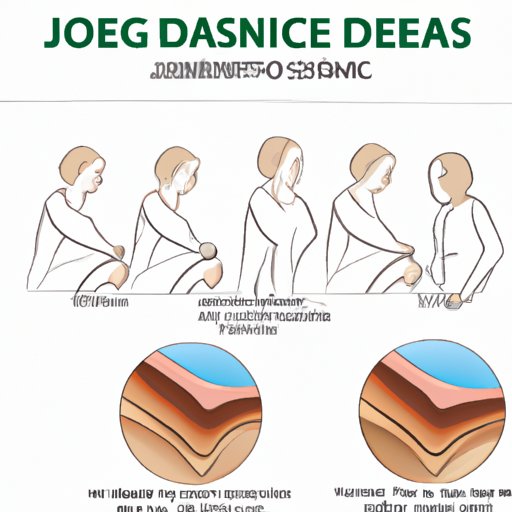
Introduction
Degenerative Joint Disease is a condition that affects millions of people worldwide and is often referred to as osteoarthritis. When you hear the term arthritis, you might think of a condition that affects older individuals’ joints. However, Degenerative Joint Disease is not just limited to older people; it can happen to anyone. This article aims to provide you with an in-depth understanding of what Degenerative Joint Disease is, its underlying causes, symptoms, treatment options, prevention strategies, and coping mechanisms.
Explaining Degenerative Joint Disease: Causes, Symptoms and Treatment Options
Degenerative Joint Disease is a prevalent type of arthritis that occurs when the cartilage that cushions the joints wears down. Cartilage is a smooth, elastic substance that cushions the joints, which helps bones glide over each other with ease. When cartilage wears down, bones rub against each other, causing pain, stiffness, and swelling of the joints.
The wear and tear of cartilage over time are the main underlying cause of Degenerative Joint Disease. Other factors that can contribute to the development of the disease include obesity, joint injury, genetics, and certain medical conditions. The disease mainly affects weight-bearing joints such as the knees, hips, and spine.
Some of the common symptoms exhibited by those with Degenerative Joint Disease include pain, stiffness, swelling, and reduced range of motion in the joints. Individuals may also experience crunching or rubbing sensations during movement.
Treatment options for Degenerative Joint Disease include pain management techniques, (such as NSAIDs, Tylenol, or tramadol), physiotherapy to improve joint flexibility, and corticosteroid injections to reduce joint inflammation. In severe cases, surgery, such as joint replacement or arthroscopy, may be recommended.
Impact of Aging and Lifestyle on Degenerative Joint Disease
Age is considered one of the most significant risk factors for developing Degenerative Joint Disease. As we age, the cartilage in our joints slowly wears down, making it more prone to damage and less flexible. Lifestyle factors such as diet, exercise, and weight management can also be key players in an individual’s susceptibility to developing the disease.
Lifestyle choices like being overweight or leading a sedentary lifestyle can exacerbate an individual’s risk of developing Degenerative Joint Disease by putting increased pressure and stress on their joints. Additionally, smoking and poor nutrition can weaken joints and cartilage, making them more prone to wear and tear.
However, making lifestyle changes like exercising regularly, maintaining a healthy weight, and quitting smoking can go a long way in reducing an individual’s risk of developing Degenerative Joint Disease.
Preventing and Delaying Degenerative Joint Disease
Preventing or delaying the onset of Degenerative Joint Disease involves making certain lifestyle changes. Incorporating a healthy diet consisting of anti-inflammatory foods that are rich in vitamins and minerals can help protect joints. Maintaining a healthy weight by using a balanced diet and regular exercise can help alleviate pressure and minimize stress on joints.
Low-impact exercise, such as swimming or cycling, can also help strengthen muscles and maintain flexibility without straining the joints. Furthermore, avoiding repetitive motion and impact activities that can cause joint injuries is also crucial in minimizing the risk of developing Degenerative Joint Disease.
Living with Degenerative Joint Disease: Understanding the Challenges and Coping Strategies
Living with Degenerative Joint Disease can be challenging for many people, as it can impact their everyday life by causing chronic pain and mobility issues. However, by understanding the disease and making lifestyle modifications, individuals can overcome many of these challenges.
Simple strategies, such as using assistive devices like braces or splints, can help reduce pain and improve mobility. Additionally, enlisting the help of family and friends, participating in physical therapy, or using meditation and relaxation techniques can help individuals manage stress and improve their mental well-being. Counseling and therapy can also be helpful in coping with depression or anxiety caused by the impact of the disease.
Alternative Treatments for Degenerative Joint Disease: A Look at Natural Remedies
Some alternative treatments and natural remedies have also been found to be effective in managing the symptoms of Degenerative Joint Disease. Acupuncture, for instance, can stimulate the body’s natural pain relief mechanisms, while nutritional supplements like omega-3 fatty acids and glucosamine-chondroitin can help reduce inflammation and protect joints.
Other natural remedies such as herbal remedies, massage, and magnet therapy have not been proven scientifically to be effective but can be anecdotally helpful for some individuals.
Conclusion
For those living with and managing Degenerative Joint Disease, the challenges can be many, but by understanding the disease, its underlying causes, and treatment options, individuals can take proactive steps towards managing their symptoms. The impact of aging and lifestyle choices cannot be overstated, and individuals can reduce the risk of developing the disease by making simple lifestyle choices, particularly maintaining a healthy weight, engaging in low-impact exercise, and following a balanced diet. Finally, by using alternative treatments and natural remedies, individuals can enhance their treatment plan, alleviate symptoms, and manage the disease’s everyday challenges efficiently.




